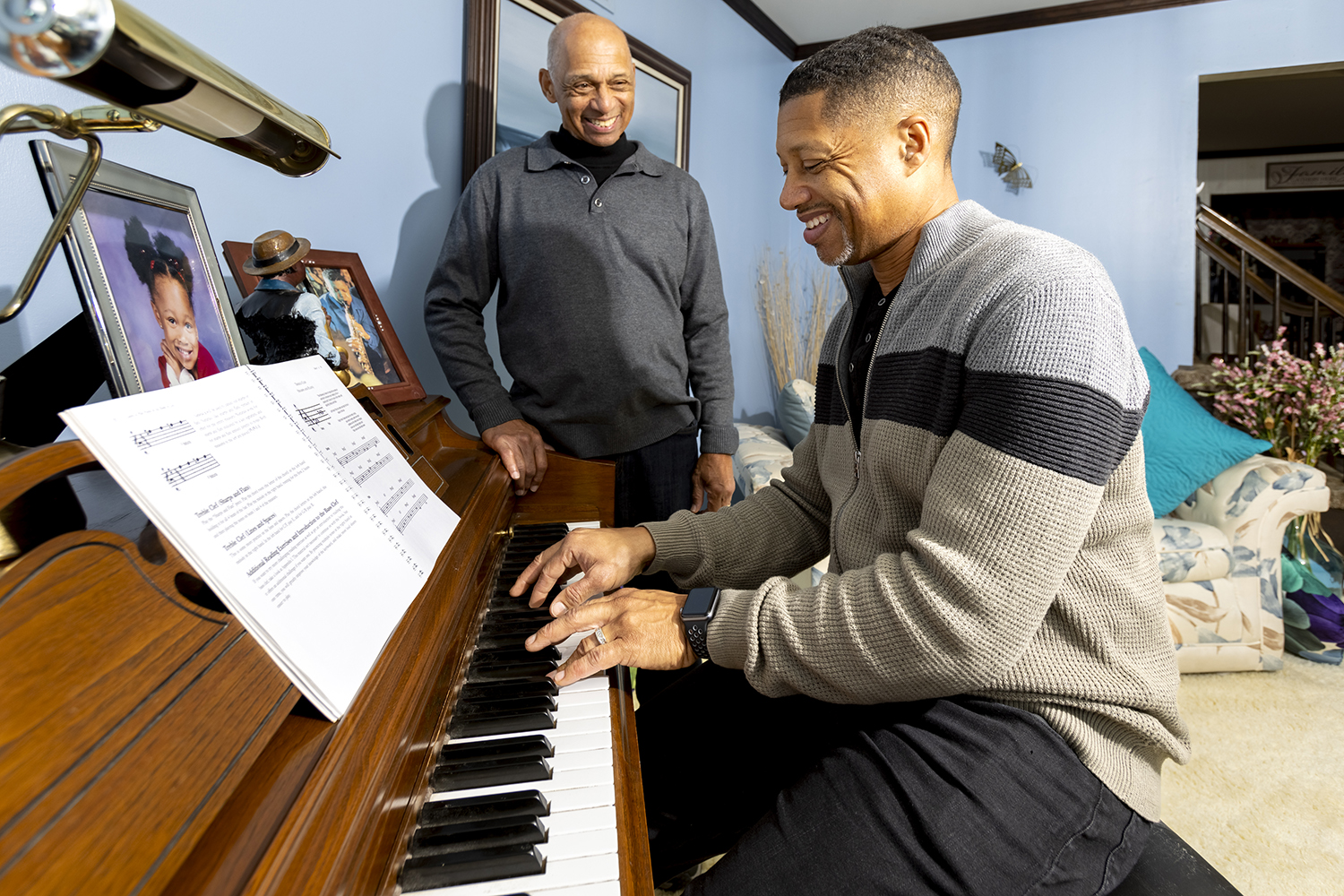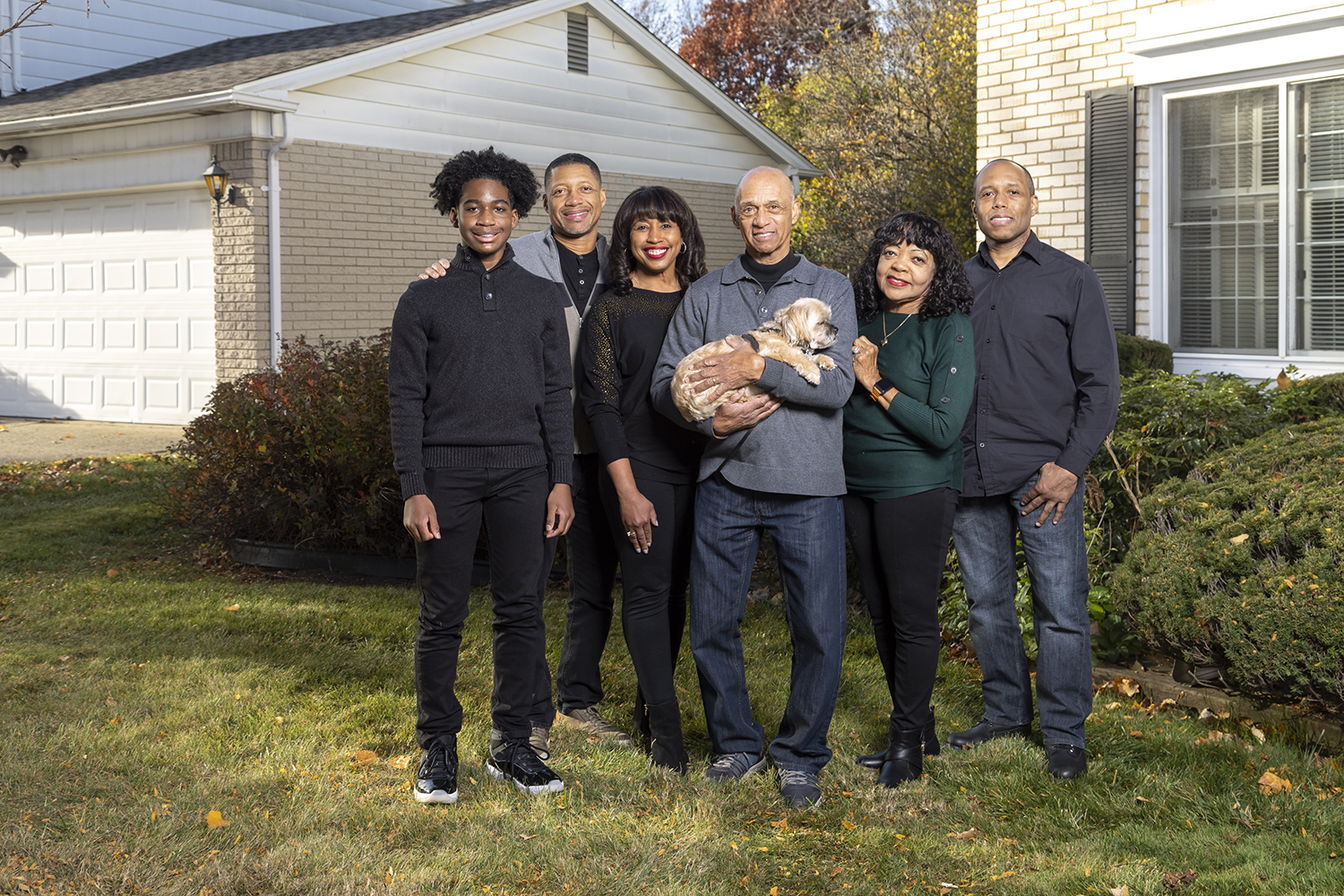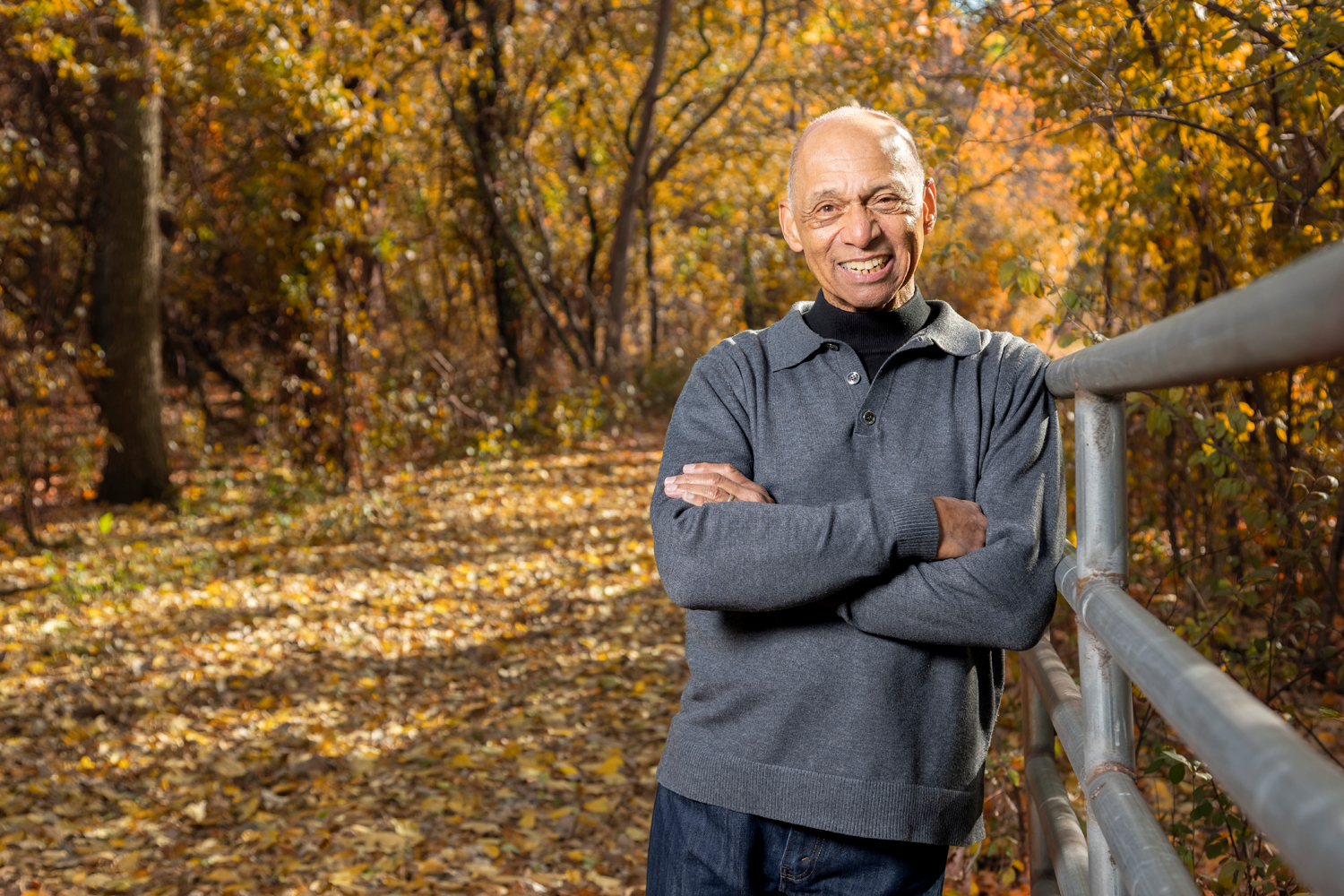ON AND OFF FOR MORE THAN A YEAR, James R. Scott had noticed blood in his urine. Each time, he checked in with his primary care provider and received a prescription for an antibiotic to treat a suspected urinary tract infection. After taking the antibiotic, the blood would go away for a while, but then it would come back.
“I wasn’t the type to run to the doctor,” remembers 76-year-old Scott, who frequently would call his doctor to get the prescription.
In May 2015, the bleeding was different, and Scott made an appointment. His urine sample was completely red. “Guess what? You have a little urine in your blood,” his doctor said, facetiously.
In the weeks that followed, Scott, who lives in Southfield, Michigan, was diagnosed with bladder cancer. He ultimately opted to have his bladder removed and a new one built from part of his intestinal tract. An arduous recovery followed as he adjusted and learned to use his new bladder. But Scott welcomed the challenges, and after treatment and recovery, he seized the opportunity to make an impact on the lives of others by sharing his story and advocating for people with bladder cancer.
A Little-Known Cancer
Bladder cancer typically starts in the cells that line the bladder, though it can occur in other parts of the urinary tract. It’s the seventh most common cancer in the United States—more than 81,000 new bladder cancer cases are diagnosed each year. Men are more likely than women to get bladder cancer, and it occurs most frequently in adults over age 55. Yet despite its prevalence, most people know very little about the disease, according to the Bladder Cancer Advocacy Network (BCAN).
Until he was diagnosed, Scott was among those in the dark about this cancer. “I had never heard of anyone who had bladder cancer. It was totally foreign to me, to my family,” he says.
The most frequent symptom of bladder cancer is blood in the urine, but blood in the urine can also be a sign of many common conditions, including urinary tract infections, kidney stones and prostate enlargement. Other symptoms of bladder cancer include pain or burning when urinating and feeling the need to urinate urgently or frequently. While Scott noticed the blood in the urine, he did not notice any other symptoms.
Smoking is the biggest risk factor for bladder cancer. The American Cancer Society estimates that half of all bladder cancers are caused by smoking. Yet Scott never smoked. He was fit and active. He exercised daily and enjoyed walking, running, cycling and swimming.
Understanding how exposure to certain substances can lead to bladder cancer.
How do carcinogens such as cigarette smoke or a chemical in Agent Orange affect the bladder? Carcinogens can be breathed in, ingested through contaminated food or drink, or even absorbed through the skin. These chemicals enter the bloodstream and head for the kidneys. The kidneys filter about a half cup of blood a minute, removing waste, toxic substances and extra liquid to make urine. As part of normal human physiology, the bladder can hold urine for long periods of time. When urine is retained, “potential carcinogens get concentrated in the urine and bathe the walls of the bladder,” says Jeffrey Montgomery, a urologic oncologist at the University of Michigan Rogel Cancer Center in Ann Arbor. Over time, these exposures increase the risk of tumor-forming mutations occurring in the cells lining the bladder.
However, while serving in the Army during the Vietnam War, Scott came in contact with Agent Orange, an herbicide used by the U.S. military to clear vegetation. Agent Orange exposure is a risk factor for bladder cancer. In fact, in 2021, the U.S. Department of Veterans Affairs added bladder cancer as a presumptive condition, a health condition that qualifies for additional disability benefits, for those who had been exposed to the chemical during their service. Certain other professions also have higher incidences of this type of cancer. For example, painters, machinists, hairdressers and truck drivers have an increased risk for bladder cancer because of the chemicals they are exposed to at work.
Pushing Forward
On May 8, 2015, Scott was admitted to the hospital, where a urologist performed a procedure called a cystoscopy using a scope and camera to look inside the bladder and urethra. The urologist found about two dozen tumors—one the size of an orange. On that day, Scott’s wife, son and daughter-in-law gathered in the hospital room and learned of Scott’s diagnosis. His family members got quiet, remembers Scott. “The C word is something that everyone has learned to fear,” he says now. But Scott looked at the physician, unperturbed, and calmly asked, “So I got cancer, what’s next?”

James R. Scott enjoys a moment at the piano with his son Randy Scott. Photo by Marvin Shaouni
In the coming months, Scott underwent additional tests. He had a procedure called a transurethral resection of bladder tumor (TURBT). During the procedure, a urologist uses a small tool called a resectoscope to remove the tumors and then examines the tissue to classify the type and grade of cancer. Scott’s cancer cells were made up of a mix of papillary and flat carcinomas (carcinoma in situ). Papillary carcinomas are slow-growing tumors that project into the bladder, like bushes, from the bladder wall. Carcinoma in situ (CIS) tumors, which lie flat against the inside surface of the bladder, are considered a high-grade, aggressive form of bladder cancer.
The urologist removed all cancerous tissue from Scott’s bladder but explained there was a strong likelihood the tumors would come back due to the aggressive nature of CIS. The cancer could then spread to other parts of the urinary system, including the kidneys, so he would likely need to undergo periodic treatments as the cancer recurred. Another option was to have his bladder removed.
Taking On a Challenge
Scott opted for the surgery. The long recovery would be arduous—but, as he tells it, hurdles only provide opportunities that “make us healthier, wealthier and smarter.” Instead of spending time feeling overwhelmed by his diagnosis, he looked to what was ahead.
“Accepting and working through challenges in life is something I have had to do since elementary school,” says Scott, who is Black and grew up in West Virginia in the 1950s and 1960s. Early on, he realized that some people viewed people of color as a “problem.” “As I grew older, I learned that it’s not what people call you that makes you what or who you are, but what you answer to,” he says. “I adopted the philosophy that I have no problems and will not take on yours.”
Scott honed this positive mindset as a manager in corporate America, working for General Motors for many years, and later at his own company where he managed musicians and entertainers. When he received his cancer diagnosis, he was managing his daughter-in-law’s podiatric practice and his son’s career as a professional jazz saxophonist. Scott traveled most weekends from his home in the Detroit suburbs to theaters, festivals, churches and other venues around the Midwest, coordinating lighting, sound checks and musicians’ schedules.
“I learned to lean on my faith, pack my patience and keep my sense of humor,” says Scott. “To me, these qualities embody the essence of a good manager, whether managing through my work life or through life with cancer.”
Scott’s cool-under-pressure attitude, even with cancer, doesn’t surprise his daughter-in-law, Tara Long Scott. “He has a strong faith and a fighting spirit. Whatever task he’s taking on, he’s going to make it happen. That’s just his personality,” she says.
New Bladder, Long Recovery
Prior to the surgery, Scott’s wife, Eyvonne, helped her husband explore options for a new bladder. One choice for reconstruction was an internal pouch created from the colon, but it would need to be drained with a catheter multiple times a day. Scott felt this option would get in the way of his active lifestyle. He chose neobladder reconstruction—a procedure in which a surgeon takes a portion of the small intestine to make a new bladder—because it “kept the plumbing essentially the same,” he says.
For the bladder reconstruction, his surgeon took 24 inches of his small intestine to create a new, internal pouch for storing urine. Urine could pass through it like a normal bladder, but unlike a normal bladder, a neobladder lacks the nerve connections to the brain that tell a person it’s time to go, and the strong muscles that allow the natural bladder to release urine. “The intestine isn’t smart. It doesn’t know it’s been made into a new bladder,” says Jeffrey Montgomery, Scott’s urologic oncologist at the University of Michigan Rogel Cancer Center in Ann Arbor. It has to be trained to function.
Recovery is long and takes patience and dedication. Complications, including urinary tract infections, can arise. “It’s a higher-maintenance type of urinary diversion. The patient has to be absolutely committed to doing whatever it takes to make this work,” Montgomery says, adding that Scott’s attitude and his methodical approach made him an ideal candidate for the procedure.
Before surgery, Scott had several rounds of chemotherapy. Bladder removal surgery can cure the disease as long as cancer has not spread outside the bladder. A course of chemotherapy before surgery is intended to take care of any cancer cells that may have implanted elsewhere in the body, explains Montgomery.
Scott also participated in an exercise program as part of a study that examined whether exercise before bladder removal surgery could help people prepare physically for the long recovery afterward. During the four-week program, Scott walked on a treadmill several times a week, completed a weight training program and did lots of planks, exercises that build strength in the abdominal muscles.
In December 2015, Scott underwent laparoscopic bladder removal and neobladder reconstruction. For the first few weeks after surgery, urine left his body through a catheter into a bag to give his new bladder a chance to heal. Then came the work of training the neobladder.

James R. Scott holds his dog, Tyler, surrounded by family members. From left are grandson Jordan, son Randy, daughter-in-law Tara, wife Eyvonne, and son Ryan. Photo by Marvin Shaouni
Scott had to void on a schedule, every two hours at first. That meant setting an alarm to wake him at night because he could no longer feel the urge to go and didn’t want to risk overextending the neobladder. He had to learn to recognize the new sensations of intestinal fullness or bloating that would tell him when it was time to void. Then he had to train his abdominal muscles with strengthening exercises to press down on the new bladder, forcing it to empty. He also had to train his pelvic floor muscles to hold in the urine, then relax when it was time to void.
It took more than a year for him to recover and train his new bladder to properly function, Scott says. Now, almost seven years later, he still experiences occasional leakages, and he’s more prone to urinary tract infections, the result of mucus production by the intestinal cell wall that now forms his bladder. But he’s cancer-free and back to a busy, active lifestyle. Doctors keep a close eye on his neobladder with yearly MRIs and monitor his kidney function with regular bloodwork.
Sharing His Testimony
Feeling grateful for his journey, Scott now lives by a Scripture verse that he paraphrases as: “To whom much is given, much will be required.” He recalls looking for ways to help others in similar circumstances in the aftermath of his surgery and recovery.
He first spoke at a patient support group meeting at the University of Michigan Rogel Cancer Center and loved it. Montgomery told him about BCAN, and Scott became part of the organization’s speakers bureau. He’s involved with the Black Men’s Cancer Action Council in Detroit and is an ambassador for and on the board of directors of Gilda’s Club, a cancer support group with branches nationwide. He speaks at churches and community centers.
His advocacy plays to Scott’s strengths, his daughter-in-law says. “Jim never met a stranger,” she laughs. “He has this really outgoing personality, and he’s always willing to help others.”
Helping others is an important part of what Scott now considers to be his life’s work. “People say to me, ‘I never heard about bladder cancer until you came and talked to us,’” he says. He wants to change that by “trying to find ways to educate people—Black, white, anyone underserved or underprivileged,” he says. His goal is to help people understand what is going on in their bodies and advocate for their own health. “I want to be a beacon or a light to someone.”
Cancer Today magazine is free to cancer patients, survivors and caregivers who live in the U.S. Subscribe here to receive four issues per year.





